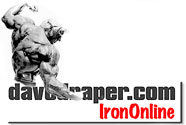Knee Problems from Squatting
<While on vacation I was doing some heavier than usual squats and my knee began to bother me. After the workout the knee was pretty sore and made a popping/snaping noise when I moved it. I've never had knee problems, this is a first. With ice it now seem much better. I'm just hoping this is not the start of something bad! Anyone experience this problem? Gary>
What you described is not uncommon. First, make certain you are not "bouncing" out of the bottom position. Keep it REAL tight all the way down and "drive" through your heels. As long as these points are in place and you are warming-up sufficiently (not excessively), look to strengthening your hamstrings. Perform leg curls at a slower tempo (4 seconds UP/hold 2 seconds/4 seconds DOWN), applying constant "positive" tension throughout each rep. Go pretty heavy (4-6 reps) for 3-4 sets. Hamstring strength is MOST important for knee stability. Forget about leg extensions for now except UNILATERAL version for 2-3 sets (no "snapping" at top).
In Divine Health,
Vince McConnell
ET Fitness Ent.
-----
<I'm 44 years old, started back training 3 years ago. Lately when I do squats I feel ligament pain in the knee area. It doesn't bother me when I do leg presses and leg curls and I don't use a lot of weight so I cannot figure out what could cause this! Any suggestions on what Icould do to get around this? Matt>
Do you warm up before you start lifting -- i.e. approx. 10 min. on a stationary bike (or whatever)? And I mean a true warm- up. You should barely break a sweat at the end of 10 min.
Also, you might try doing some hamstring work before you squat. My boyfriend was having problems with his knees, as well (he's 37), and he decided that maybe weak hamstrings were the problem. You might want to re-evaluate your hamstring workout to make sure that you are hitting those with equal intensity to your quads.
Gerri
-----
Gerri makes a great point. Go with supersetting squats with leg curls. Perform the squats driving through your heels and leg curls with a slower tempo of 4 seconds up/hold 2 seconds/2 seconds down for sets of 6-8 reps. This has worked quite well for others with knee pain and actually helped to heal the knees by strengthening the "weak link". Never hyperextend the knees at beginning of leg curls - keep slight bend.
In Divine Health,
Vince McConnell
ET Fitness Ent.
<The "heel on block" idea has given me some undue stress on my knees.>
Knee trauma from squatting with heels elevated can be avoided by descending slowly into the below parallel position. Such an M.O. will limit the amount of weight one needs to make progress. This is also a way to help maintain an upright posture, thereby minimizing excessive stress on the lower back, something that can be a problem for those using a flat-footed stance. Or....for the safest squats possible, one can use the Frank Zane Leg Blaster, though unfortunately most gyms do not have them.
MrNH
<I have always known that squats is THE exercise, but they bothered my knees.>
You may not have the natural leverage for shoulder-width squats. Try going a little wider with toes pointed SLIGHTLY outward for balance. Then you will not only eliminate the pain in the knees, but will find that you will hit parallel with no problem.
Squatting IS a tough exercise when done properly. So just try to take a few weeks to RELEARN the squats with incredibly light weights. Start with 135 on the bar and focus on the weight traveling, how it rests on your shoulders, how your knees bend, how your hips bend, how your feet move, etc. Then add weight gradually and work back up to what you are used to using for working weight. GRADUALLY.
Jeff
<I've heard that leg extensions damage the knee. Any truth to this?>
Having run a sports rehab clinic for a number of years, I think my insights may be of interest. First, you need to consider the strength curve of the quad. The greatest amount of torque is generated in the middle of the range of motion. I have personally tested patients on the Medx knee machine who have unilaterally (one leg only) generated close to 200 foot-pounds of torgue in an isometric mode at midrange. Yet this very same fellow was capable of producing less than 5 pounds of torque at full extension.
The upshot of this is that most of us should be using far less weight in leg extensions than we are used to handling to fully exhaust the quads in the extended position and not rely on momentum to finish the rep for us.The momentum generated by 'throwing' the weight into extension is capable of producing tremendous shearing forces that may have the potential to seriously damage the knee's connective tissue.
Rep cadence is of paramount importance. The concentric (positive) half of the rep should take at least 2 seconds followed by a brief pause at full extension. The eccentric (negative) should take at least 4 seconds. From what I have seen and experienced, there is probably no need to do fewer than 10 reps. After all, leg extensions are an isolation exercise, not a compound exercise. Keep on pumpin'!
MrNH77
Click here to go back to the IOL Leg Training Discussion Contents

